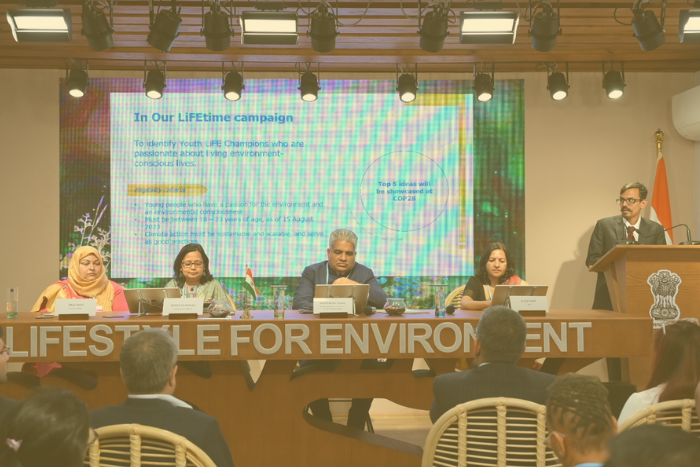Environment minister Bhupendra Yadav said the strategy is based on two themes of “climate justice” and “sustainable lifestyles”
India revealed its Long Term Low Carbon Development Strategy (LT-LEDS) at COP27 in Egypt on Monday. The country joined a list of 57 other nations that have submitted their LT-LEDS so far. The strategy relies on four basic pillars that have so far informed India’s climate policies–low historic contribution toward global warming, significant future energy needs of the country, national circumstances as it pertains to committing to low-emission growth strategies, and the need to build climate resilience.
“We are now presenting India’s Long-Term Low-Carbon Development Strategy that articulates India’s vision and action plan for achieving its NDC goals and the target of net zero emissions by 2070. And we are placing before all, the key elements of India’s transition to a low-carbon development pathway,” said environment minister Bhupendra Yadav during the release.
‘India’s LT-LEDS rests on seven key transitions to low-carbon development pathways,’ the 100-page document specifies. These include the following:
1) Low-carbon development of electricity systems
In order to achieve this, the Indian government is keen to focus on the expansion of renewables and strengthening the grid. Demand-side management will be another area of focus along with utilising fossil fuels rationally with one eye on the country’s energy security. The document also mentions developing a green taxonomy for the power sector.
2) Development of a low-carbon transport system
The Indian government intends to make this shift by focusing on improving fuel efficiency, planning a phased transition towards cleaner fuels, opting for electrification across multiple modes, improving traffic management and using intelligent transport systems.
3) Promoting adaptation for sustainable urbanisation
Adaptation measures will play a key role in the development of urban areas. This includes climate-responsive and resilient building design in both existing and future constructions. The government also is keen to promote low-carbon municipal service delivery that focuses on efficient resource, water and waste management.
4) Decoupling growth from emissions and developing a low-emission industrial system
Natural and bio-based fuels materials will be increasingly used to improve energy and resource efficiency across the industrial sector. The government will also explore fuel switching and electrification in manufacturing when viable. Something to note is the mention of decarbonisation of the Micro Small and Medium Enterprises (MSME) sector, which has been missing so far from India’s decarbonisation strategy. This despite the sector forming a large part of India’s industrial roadmap, with significant energy demand and employment potential.
5) Removing CO2 and related engineering solutions
This is a new sector that the government is keen to explore. The document acknowledges the need for international support through innovation, technology transfer, and climate finance. The strategy will be to minimise socio-economic, livelihood and ecosystem impacts through training, capacity building, and explore public-private partnerships for projects that require more intensive resources. The government is still unclear on whether this would be economically and technologically feasible. But it did release a draft 2030 roadmap for carbon capture utilisation and storage (CCUS) in the oil and gas sector earlier this year. Some pilots are currently on for enhanced oil recovery through CCUS from ongc and Indian Oil.
6) Enhancing forest cover with one eye on socio-economic and ecological considerations
Preservation, restoration and conservation of plants, animals and genetic resources within India’s forests forms the crux of this strategy. The livelihoods of local communities and their dependence on forests for social and cultural activities will also be considered when developing sustainable growth strategies.
7) Recognising economic and financial aspects of low-carbon development
The document recognises the strain that decarbonisation can put on the country’s financial systems. India will, therefore, focus on mainstreaming climate finance and developing new multilateral mechanisms that will promote innovation and technology development.
India’s LTS was welcomed by experts. “The strategy emphasises, in particular, the necessity and willingness of the international community to provide space for growth to developing countries like India on the basis of equity and avoid linkages with trade,” said RR Rashmi, Distinguished Fellow, The Energy Resource Institute (TERI).
The document’s long-term vision was also acknowledged. “Its sectoral approach is important, since some sectors like transport currently have a small share in GHG emissions but are projected to grow in the coming decades. Involving several sectoral ministries in the LTS is commendable as they can coordinate to introduce transformative actions that go beyond current programs,” said Ulka Kelkar, Director, Climate Change programme, World Resources Institute (India).
Vaibhav Chaturvedi, Fellow, Council for Energy, Environment and Water, however, did question why carbon pricing was not mentioned. “The LTS could have included carbon pricing through a domestic emissions trading scheme as a key element of India’s strategy, given that the government has already announced the creation of the same in India.”
About The Author
You may also like
Zero sharm game: COP27 saves face with minimum common agreements
Issue of mitigation in agriculture remains a sticky subject
Oil and gas lobby makes its presence felt more than ever at COP27
Question of ‘who will pay’ loomed large over LTF negotiations at COP27
Mitigation work programme: Equity gone, rich countries push hard to shift emission cuts to Global South at COP27


